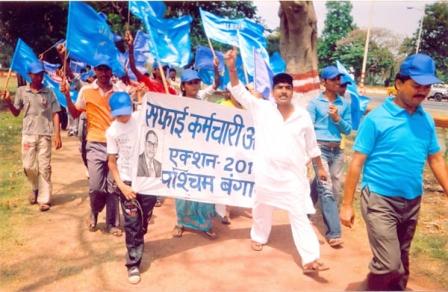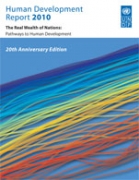Lifestyle
Human development report 2010 - The real wealth of nations - United Nations Development Programme
Posted on 10 Nov, 2010 12:50 PMUnited Nations Development Programme (UNDP) has recently published the 20th Anniversary edition of its Human Development Report (HDR) which presents the latest Human Development Index (HDI). The premise of the HDI reports is simple - national development should be measured not simply by national income nor should an individual’s well-being be evaluated by money alone, as had long been the practice, but also by life expectancy and literacy.
Income is of course crucial - without resources, any progress is difficult. Yet there is a need to gauge whether people can lead long and healthy lives, whether they have the opportunity to be educated and whether they are free to use their knowledge and talents to shape their own destinies.
Launching Samajik Parivartan Yatra
Posted on 25 Oct, 2010 01:29 PMManual scavenging is the most obnoxious and inhuman practice violating the dignity and human personhood of safai karmacharis. It involves the engagement or employment of sections of people to manually dispose human excreta from dry latrines with bare minimum aids such as scrappers, brooms and baskets.
Manual scavenging is integrally linked with caste system and is imposed on certain dalit sub-caste groups particularly on their women. As a result all persons engaged in manual scavenging are dalits, and of them 82% are women.
"Gujarat farmers fight against climate change: Adopt technoloxxgy to conserve resources and maximize benefits" : News roundup (15-21 October 2010)
Posted on 22 Oct, 2010 11:25 AMClimate Change
Construction in and around a 300 years pond which is a heritage site in West Bengal
Posted on 12 Oct, 2010 04:42 PMI, on behalf of the local people bringing to your notice that we have a 300 years-old pond in our locality which is known as Bhabani Pathak Dighi which is declared as a Historical and Heritage Site by the West Bengal Heritage Commission.It is in the City Centre area adjacent to the Ambuja Housing.
The total 8.48 arcs of pond and its surroundings (area not known) have been declared as a. A tunnel was found when a construction work was going on beside the pond and some renovation work has also been done there accordingly by West Bengal Heritage Commission (annexure no 13). Now the pond is only approx 3.5 arcs left and rest has been filled.
This awesome site has shot to fame by the novel Durgesnandini of great Bengali novelist Bankim Chattopadhyay.The novel describes the best featuring and intricacies of these tunnels and the pond.
Asian Development Bank (ADB) launches second Asia-Pacific video contest
Posted on 12 Oct, 2010 04:40 PMArticle and Image Courtesy: Asian Development Bank (ADB)

The Asian Development Bank (ADB) is launching its second video competition which is open to all aspiring filmmakers across the globe.
Ramlila performed on a river, in Saharanpur after 30 years !
Posted on 12 Oct, 2010 03:22 PMSaharanpur (9 Oct) : History was created in Saharanpur once again. Today, Paondhoi had thousands of visitors (e.g.
‘Samajik Parivarthan Yatra’ (National Yatra for Social Transformation)
Posted on 11 Oct, 2010 11:51 AM The historical ‘Samajik Parivarthan Yatra’ (Rally for Social Transformation), has been started to consolidate the gains of the movement for total eradication by liberated safai karmacharis who for the first time are bonding with one another began the journey for social change together, to inspire others who are still engaged in manual scavenging to free themselves from the obnoxious practise and regain their sense of dignity, and also to achieve their rightful claims for the rehabilitation package and dignified alternative livelihoods on the one hand; and on the other, to motivate civil society to reject the heinous practice of manual scavenging. The Bus Yatra has been planned to start from five different corners of India, and traverse through 160 districts in 20 states and finally culminate in New Delhi with a large rally. Each route has been named after an eminent person who contributed to social change in a revolutionary manner.
The historical ‘Samajik Parivarthan Yatra’ (Rally for Social Transformation), has been started to consolidate the gains of the movement for total eradication by liberated safai karmacharis who for the first time are bonding with one another began the journey for social change together, to inspire others who are still engaged in manual scavenging to free themselves from the obnoxious practise and regain their sense of dignity, and also to achieve their rightful claims for the rehabilitation package and dignified alternative livelihoods on the one hand; and on the other, to motivate civil society to reject the heinous practice of manual scavenging. The Bus Yatra has been planned to start from five different corners of India, and traverse through 160 districts in 20 states and finally culminate in New Delhi with a large rally. Each route has been named after an eminent person who contributed to social change in a revolutionary manner.
Analysis of the UN General Assembly's Resolution on Right to Water and Sanitation
Posted on 30 Sep, 2010 06:47 PMThe historic UN General Assembly Resolution declaring Water and Sanitation as a Right, was passed on the 28th July 2010.
What is surprising is the complete silence to this UN Resolution from some of the countries who have been traditional champions of human rights, in terms of celebrating it as a historic achievement in advocating a basic right to water and sanitation. Instead some of them went one step short of openly opposing and vetoing the UN Resolution and have heaped criticism on Bolivia for tabling this UN Resolution.
Sanitation models in Trichy, Tamil Nadu
Posted on 01 Sep, 2010 04:19 PMA few weeks back I had the opportunity to visit a couple of partners in Tamil Nadu. These two partners are facing a difficult task—sanitation and hygiene implementation through community participation. One project is in the urban slums of Trichy while the other one is a rural project a few hours outside of Trichy. These communities have open defecation rates of 90%. The problem mostly lies on the women. Women feel embarrassed and ashamed to go out in the open, so as a result they only go in the early mornings or late at night—basically during pitch black. Menstrual Health is a topic that is only now being addressed with organizations developing their own branch of sanitary napkin production, sold cheaply to women in rural areas. In addition to the burden on women, open defecation pollutes water sources, thereby leading to diarrhea, one of the biggest killers of children in the developing world.
Community organisation in groundwater management – A presentation by ACWADAM
Posted on 27 Aug, 2010 04:01 PM This presentation by ACWADAM on community organization in groundwater management deals with the processes involved in people’s mobilization and participation. The requisites of groundwater management include: resource enhancement, demand management, equitable distribution, institutional mechanism and controlling of free riding. It deals with groundwater management at a local scale when compared to aquifer management.
This presentation by ACWADAM on community organization in groundwater management deals with the processes involved in people’s mobilization and participation. The requisites of groundwater management include: resource enhancement, demand management, equitable distribution, institutional mechanism and controlling of free riding. It deals with groundwater management at a local scale when compared to aquifer management.
Aquifer management involves:
- Identification of aquifer on the basis of geology;
- Identification of recharge and discharge areas;
- Assessment of aquifer capacity and yield through aquifer mapping;
- Protection of recharge area and increasing the groundwater level through artificial recharge in recharge area (based on the geology);
- Treating groundwater as a common property resource;
- Encouraging community use of groundwater and restricting individual use;
- Putting in place an institutional mechanism and legal back up for community groundwater management;
- Awareness generation regarding groundwater and science of hydrogeology.






